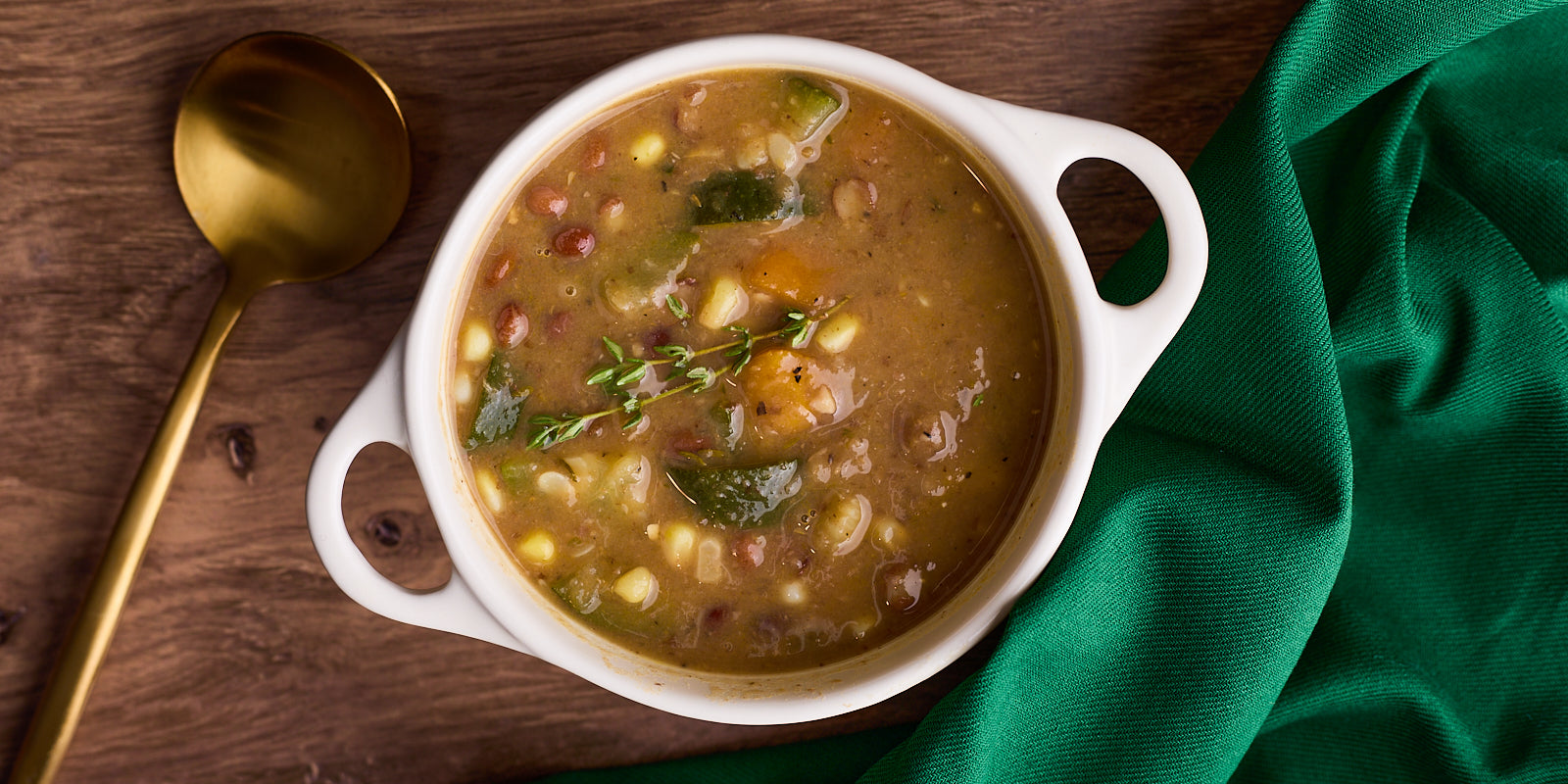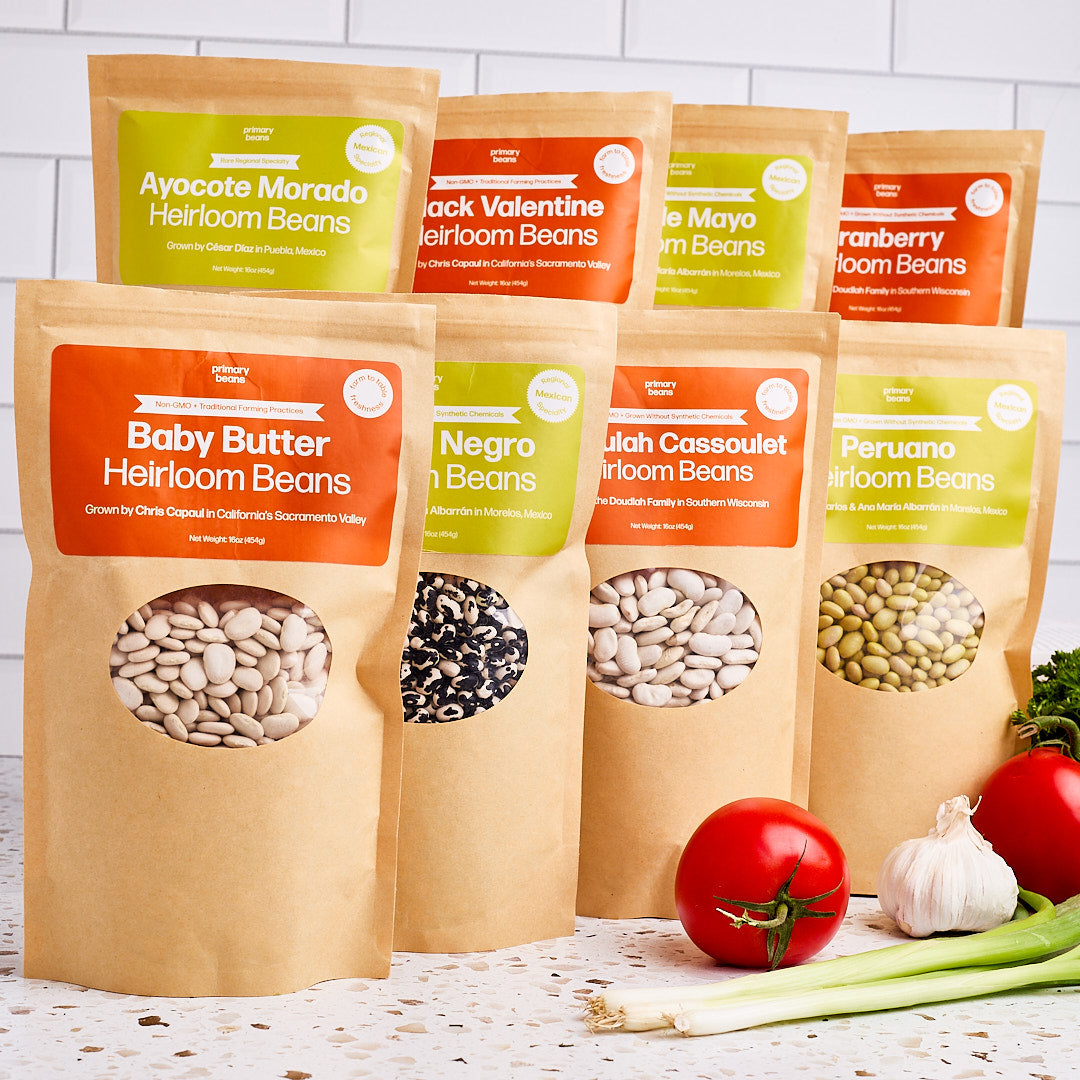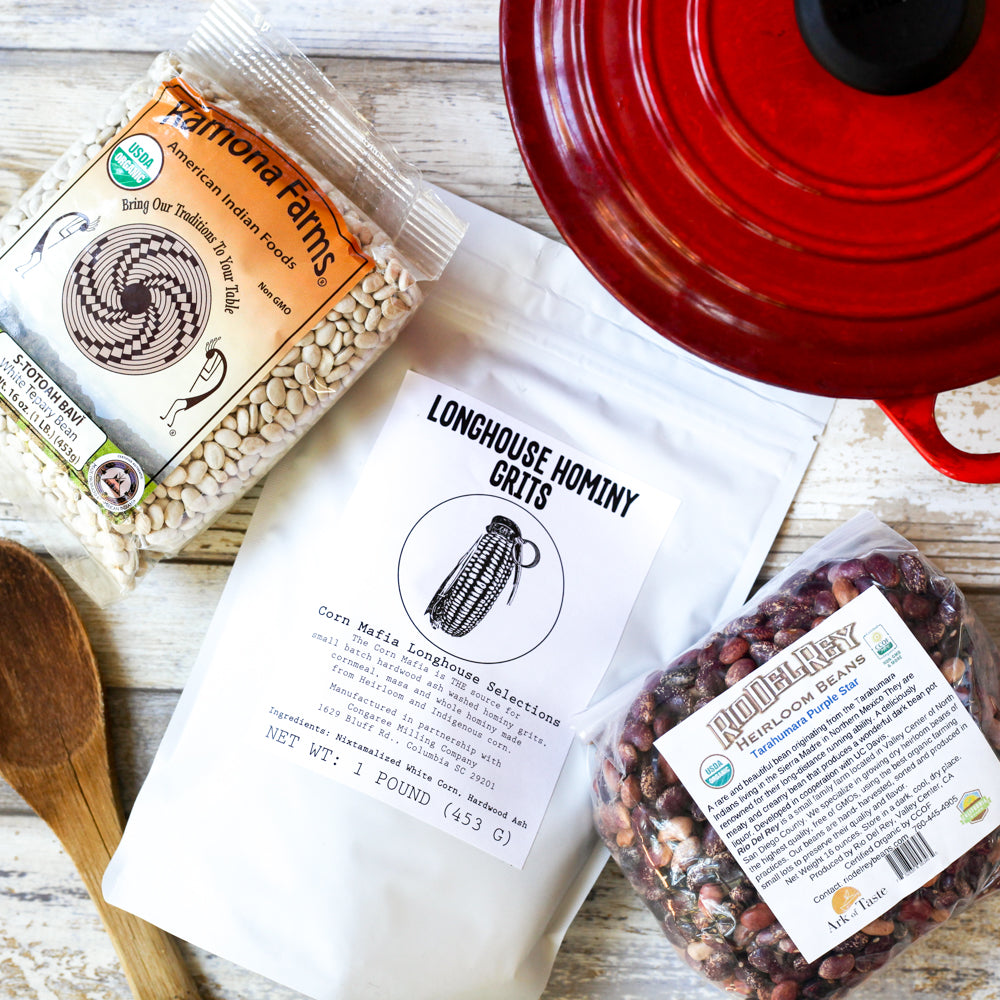10.99 FLAT RATE SHIPPING
10.99 FLAT RATE SHIPPING
SHOP

Slow Cooker Mayflower Bean 3 Sisters Soup
August 31, 2024 3 min read
This early harvest soup is perfect for when the days are still warm and the nights are cool but you have an abundance of corn and zucchini in the garden. When I was a kid September was time to go back to school and also time to help my mother pull zucchini and corn out of the garden to be "put up." Freezing and canning were things that people who lived in the country like us did at the end of every summer and we always made dinner from the garden's fresh harvest. Before you know it the we'll be deep into root vegetables and fondly remembering the days of fresh zucchini and corn. If you don't have any fresh corn you can use frozen and if the zucchini is gone you can opt for another kind of squash.
COOKING THE THREE SISTERS
The three sisters play a very important roll in Native American culture and foodways. Corn, beans and squash have been planted together and cooked together since ancient times. The beans are planted at the base of the corn, providing a natural trellis, the squash is planted around the corn and beans and the spiny leaves provide protection against predators. The beans in turn give nitrogen back to the soil for her sisters.
Almost every Native American Nation seems to have its own myths and legends surrounding the three sisters. In each story they are central to our spiritual connection to the earth. Learn more about the Three Sisters legends on our BLOG.
HIERLOM MAYFLOWER BEANS
It is said that the Mayflower arrived in the US in the 1620s, bringing with it the Mayflower bean. More accurately though, the Mayflower bean was returned to its ancestral lands by the pilgrims. An ingredient in the Slow Food Ark of Taste, the Mayflower has square shaped beans that are a beautiful creamy color with dark purple or red speckles. Like all Phaseolus vulgaris,the Mayflower would have originated in the new world, descended from beans cultivated thousands of years ago in Peru. After colonists re-introduced the Mayflower to the Americas, the bean was widely circulated among the colonists of the Carolina region of the country. The Mayflower plant has short pods that hold the small, square shaped beans. The beans are a beautiful creamy color with dark-red speckles.
COOKING TIP: CORN STOCK
You can easily buy corn stock from PlantStrong but if you've growning or buying corn on the cob, you can make delicious broth from what you might otherwise throw away. This broth freezes very well so that you can enjoy plant-based broth that tastes like summer all winter long.
To make a rich and flavorful corn stock, start by collecting the cobs left over from fresh corn on the cob. Place the cobs in a large pot and cover them with water, ensuring they’re fully submerged. Add aromatics like chopped onions, garlic, a bay leaf, and a few sprigs of thyme to enhance the flavour. Bring the mixture to a boil, then reduce the heat to a simmer. Let it simmer gently for 45 minutes to an hour, allowing the cobs to infuse the water with their natural sweetness. Once done, strain the stock through a fine sieve, discarding the solids. Your homemade corn stock is now ready to use in soups, stews, or risottos, adding a delicate sweetness to your dishes.
COOKING TIPS: STOVETOP DIRECTIONS
This doesn't have to be done in the slow cooker, it's just very convenient on days where it's still pretty warm in the kitchen during the day and you might be out in the garden doing chores before the frost hits.
In the bottom of a dutch oven sauté the onion until translucent. Rinse and pick through the beans and add to the pot with the carrots, garlic, bay leaves, thyme, kombu, salt and stock. Bring to a boil and then cover and simmer until the beans are soft (about 90 minutes). Remove and discard the thyme stems, bay leaves and kombu. Don't worry if the kombu breaks apart, just stir it in. Remove about a cup of the beans and stock and put in a blender. Blend on high and return the pureed mixture back to the pot. This makes the soup thicker and more creamy without adding dairy. Add the zucchini and corn and simmer for another 30 minutes until the zucchini is soft and fully cooked.
Slow Cooker Mayflower Bean 3 Sisters Soup
Rated 5.0 stars by 1 users
Category
Soup
Servings
4
This hearty fall soup uses the bounty corn and zucchini from the garden with delicious heirloom Mayflower Beans for an easy seasonal dinner.
Author:Lisa Riznikove

Ingredients
- 1 cup Mayflower Beans
- 2 large carrots peeled and thickly sliced
- 1 medium onion
- 3 cloves of garlic
- 2 bay leaves
- 3 sprigs of thyme
- 1 teaspoon dried oregano
-
1 4" strip of Kombu
- 1.5 tablespoons kosher salt
- 4 cups of corn stock
- 2 medium zucchinis or 1 large, diced with skin on
- 1 cup of fresh corn cut off the cob
Directions
- In a saucepan sauté the onion until translucent and put them in your slow cooker. If you have a multi-cooker like an instant pot you can do this all in the same pot by using the sauté setting. *stovetop directions are above in the notes.
- Rinse and pick through the beans and add to the slow cooker. Add the carrots, garlic, bay leaves, thyme, kombu, salt and stock.
- Cook in the slow cooker for 5-6 hours on high.
- Remove and discard the thyme stems, bay leaves and kombu. Don't worry if the kombu breaks apart, just stir it in.
- Remove about a cup of the beans and stock and put in a blender. Blend on high and return the pureed mixture back to the slow cooker. This makes the soup thicker and more creamy without adding dairy.
- Add the zucchini and corn and cook for another 30 minutes to an hour until the zucchini is soft and fully cooked.
Recent Articles
About Us
Foodocracy is dedicated to creating a more sustainable and independent food system. We support small, independent farms across the nation.
Related Recipes
Get impossible to find beans and grains shipped direct to your doorstep each month from small family farms.
We support small, family owned farms across the nation. Did you know that farmers only make an average of 10 cents on every dollar you spend at the supermarket? Working directly with farms and not middle men ensures that more money goes back to the people actually growning your food.
Get 10% Off
Sign up for delicious recipes and special offers.
**Regularly priced items only.






